The detailed renovation of the Bailey Power Plant illustrates how innovative and creative thinking can be applied to making what is old “new” again.

Threading through our recent story of the Wake Forest Innovation Quarter, images and anecdotes about the Bailey Power Plant were consistently used to illustrate the overall story of how this area of Winston Salem, North Carolina has been resurrected from an abandoned industrial site to a vibrant live-work community. The story behind the renovation of this historic building is compelling, as is the level of detail and commitment to bring this project from concept to fruition.
Initially constructed in 1947 as a coal-fired power plant for the R.J. Reynolds Tobacco Company, the Bailey Power Plant is reincarnated as a mixed-use workplace and entertainment hub in Wake Forest Innovation Quarter in Downtown Winston-Salem. The core and shell design honor the building’s historical industrial past by retaining original elements such as distressed concrete structures and blue stenciled camels; while simultaneously looking to the future with a contemporary glass and metal façade, and a north-facing rooftop addition. Slated to receive LEED Silver certification, the Power Plant comes full circle from a coal-fired plant to a restored, resource-saving icon of sustainability.
The architects were retained to complete the core and shell design, leaving open spaces with the industrial character for future tenants. Tenant upfit spaces vary, but most have a combination of open plan and enclosed offices. The work to re-purpose the 119,000 SF building was completed in 2017.
We were fortunate to connect with Lauren Frye, the Project Architect from Walter Robbs Callahan & Pierce Architects, PA who oversaw the design and construction of the project.
What program requirements were unique and required research or design requirements?
The developer’s goal was to maximize rentable square footage in the building. By adding floor plates and a rooftop expansion, the design team creatively increased the rentable square footage by nearly 210 percent. Because the building was initially designed as a working power plant-centered around machines, the design team worked to create elements that both embrace the building’s texture and history and address the human scale.
Because the building is mixed use, with retail/entertainment on the basement level and offices above, the two parts of the building are separated with a three-hour rated floor. This essentially creates two buildings per the building code, allowing for structural elements to remain non-protected on the upper levels. Without this design move, the structure would either have been hidden in walls, extensively fireproofed or painted with intumescent paint – all of which would have been costly and detrimental to the industrial aesthetic.
What kind of programming or visioning activities were used?
This project was designed for a developer, and as such the tenants were unknown at the time of design for the core and shell.
As a built asset that the community was interested in for years, there were visioning sessions held by multiple groups to envision a future life for the Bailey Power Plant. Walter Robbs produced test fits for various community-centered tenants, all of whom contributed to the vision of the Power Plant as a gathering space for residents of and visitors to Winston-Salem in the heart of Wake Forest Innovation Quarter. In the end, the office and retail mix, and the public park-like use of the coal pit were outcomes of these meetings.
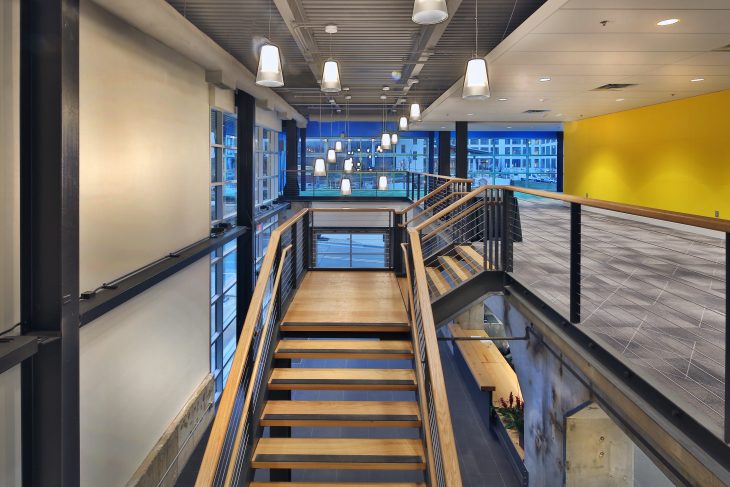
What kind of spaces were included in the initial building retrofit?
The developer wanted to create a place that would be attractive to future tenants drawn to the Innovation Quarter. The main lobby on the north side of the building provides a stunning entryway for employees and visitors, as well as a shared common space for lingering before events in the adjacent Turbine Hall (upfit as part of a separate project as a building-wide resource which often hosts public events). Meeting spaces were outside of the core and shell scope. The main lobby on the mezzanine and second floors provide public gathering spaces.

Given the original industrial nature, former use, and age of the building, what were some of the challenges of the project, especially in meeting the LEED requirements?
- Five percent of the construction budget went toward structural steel, a primary contributor to LEED points due to its recycled content (80 percent post-consumer, 10 percent postindustrial), and proximity to the project site (manufactured 120 miles away).
- Eight bicycle racks are installed on site to encourage healthy and sustainable transportation options.
- 97 percent of the existing building – excluding non-structural roofing material & window assemblies and any structurally unsound/hazardous materials – was reused, earning six LEED points for exemplary performance.
- The plant was named for the Bailey Brothers, the original owners of the site before RJR bought it in 1923.
- Shenandoah Restorations, Inc. replaced over 1,200 individual panes of translucent wire glass with vision glass in the historic exterior windows, transforming the space by giving occupants views of the outdoors for the first time.
- The renovation increased the building’s usable square footage by over 200 percent by adding three floors and an above-roof addition.
- There are two internal “stairs to nowhere” where original stairs connected mezzanines
- The blue camels painted on the concrete turbine structure surrounding the reception desk were original – not stencils added to the project by the design team as some have asked.
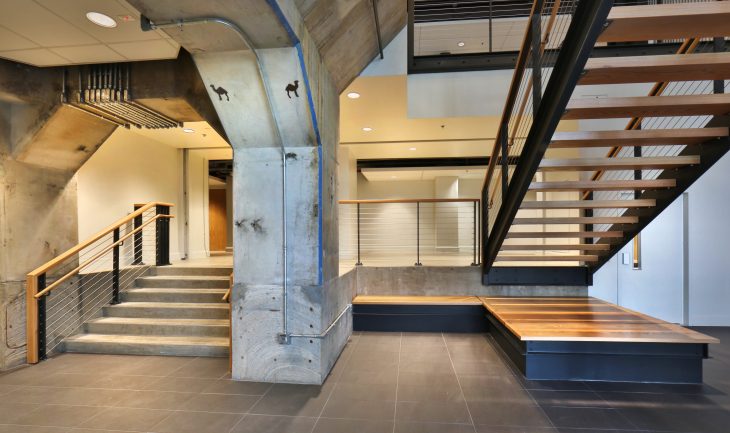
Were there any unique or unusual construction materials or techniques employed in the project?
Exterior masonry and old windows & hardware were restored on-site. Due to the amount of steel projecting from the building which historically supported equipment, the design team opted to highlight these elements through paint rather than attempt to hide them.
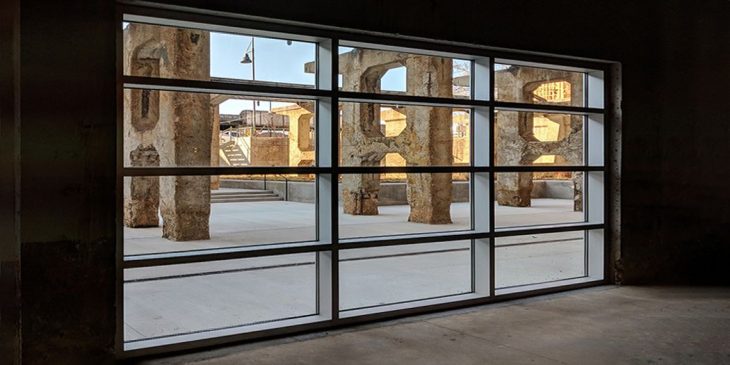
For specific examples, please describe the product, how it was used, and if it solved any particular problem.
Single pane textured glass with wire mesh was replaced with single pane glass with a pyrolytic coating. Changing out the type of windows offered the opportunity to showcase the exceptional views from the building of the surrounding park and high-rise buildings and contributed to higher energy efficiency.

What was the hard cost PSF/construction?
The cost came in at $180 PSF.
What kind of branding elements were incorporated into the design?
The existing smokestacks provide instantaneous branding for the building. Lettering and brick on the smokestacks were restored, and lights were added by the Landscape Architect (under separate contract) to enhance the skyline at night. Interior and exterior graphics were under separate contract.

What are some of the unique features of the new space?
The North lobby entrance desk, is built into the existing foundation for an original turbine.
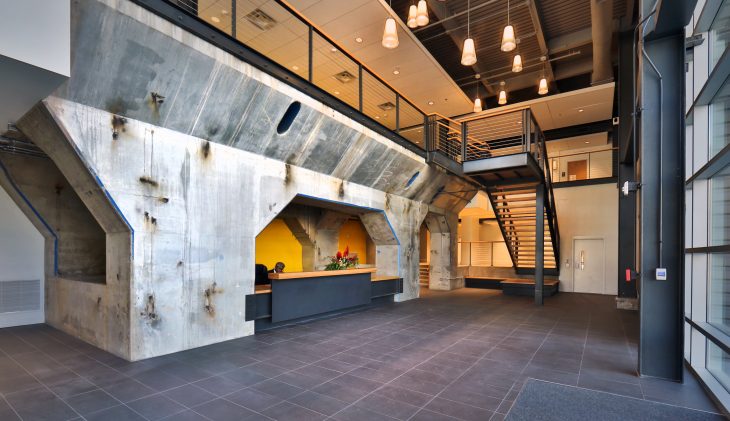
Any other interesting architectural features?
A central atrium brings natural light into the center of the building, providing daylight to interior spaces. Careful consideration was given to make sure the integrity of the original structure was maintained throughout the building.
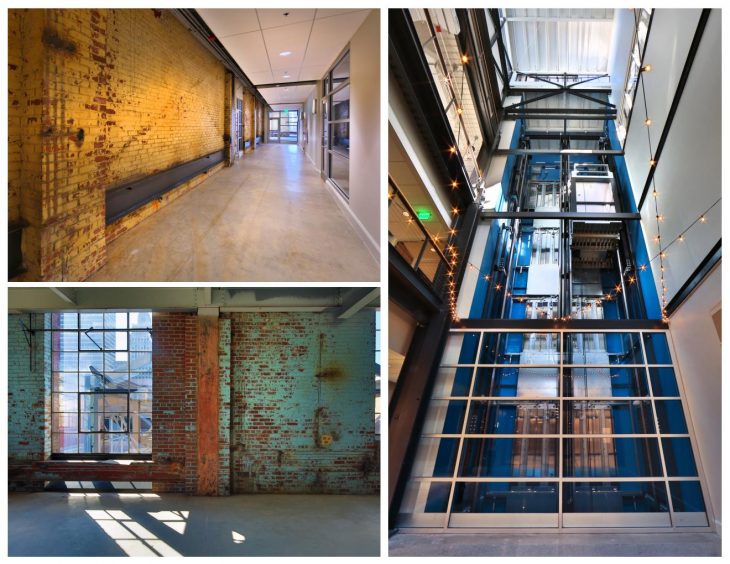
The Bailey Power Plant was positioned to be the central feature of the entire Wake Forest Innovation Quarter. The project demanded much coordination to manage not only the design but the intricate choreography of the site preparation to prepare for the renovation. Transitioning a building from industrial use to office space is not something that could happen overnight. Years of environmental abatement work was required to ensure that the structure was free of any hazardous materials, and structurally ready for its new life as a place for work, play, and innovation. This project illustrates how innovative and creative thinking can be applied to making what is old “new” again. As new tenants occupy the building and as the development of the Innovation Quarter proceeds, all the hard work on this project contributes to the revitalization of what could have been an abandoned urban site.
Learn more about Walter Robbs Callahan & Pierce Architects and the Bailey Power Plant.



[…] The detailed renovation of the Bailey Power Plant illustrates how innovative and creative thinking can be applied to making what is old “new” again. #oldtonew #toronto #hamilton #guelph #waterloo #kitchener #london #niagara #commericialinteriors #modernoffices #constructionmanagement #interiordesign #officedesign #officedecorideas #interiordesigntips #wrokspacedesign #interiorofficesolutions workdesign.com/… […]
I enjoyed so much reading this article. I’m fascinated about the concept and bringing so much life to a dead space in a modern, practical, envisioning and also ambitious project. It’s so wonderful that creative, smart minds get togethr and give birth to such a beautifil place. Congratulations and best of success!